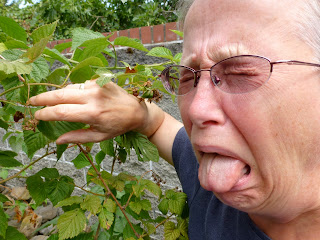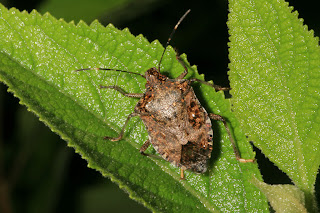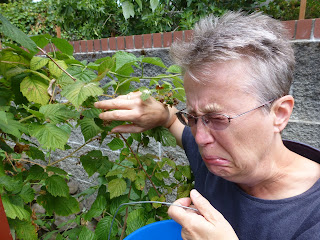Sometimes I graze my way through my raspberry patch as efficiently nom nom nom as a caterpillar, and then I’ll pop one in my mouth and nom nom nom it will be all bleah patooie.
You can’t tell which ones are going to be all bleah patooie. What I assume is that I’ve gotten into a berry that a stink bug has just pooted on. Every now and then I see an actual stink bug. And then I think: are you a brown marmorated stink bug? And if you were, how would I tell? Would I look for…marmorations? And what would those look like? Shark music accompanies these thoughts.
“Marmorated” apparently means streaky-looking, or marbled. I see no reason the bug couldn’t have been called the Marbled Stink Bug. We already have plenty of other perfectly good marbled items, such as the marbled murrelet and the marbled salamander, and the word serves us just fine. “Marmorated” sounds like the bug has just had some countertops or flooring installed. But we’re stuck with it.
And we’re stuck with the bugs too. Sometime around the turn of the century (a phrase that used to mean something different when I was coming up) the first marmorated stink bugs arrived in or around Pennsylvania, and nobody thought it was a good idea, but now they’re all over the place. They’ve expanded their range to just about every eastern state–and Oregon.
Unlike ladybugs, stink bugs are actual bugs. This means they are members of the order Hemiptera and they have sucking mouth parts. Most of us call just about any insect, arachnid, or small crustacean a “bug,” but you don’t want to make that mistake around an entomologist. They’re prickly about the distinction, and they probably have access to ways of making your life miserable.
Speaking of making your life miserable, that’s a specialty of the brown marmorated stink bug. They damage crops, especially fruit, like a lot of other bugs. They’re resistant to pesticides, because they jam their mouthparts into a fruit before sucking instead of licking the surface the way we’d like them to. But the worst thing about this particular stink bug is it wants to spend the winter inside your house. They will swarm in via any space they can fit through, and they’re flat–if your home does not have openings big enough for a stink bug to fit through, you probably aren’t getting enough air. Once inside, their plan is to hibernate, but it’s usually too warm, so they start banging into shit and stuff. And whenever they get upset, banging into shit and stuff, they emit a noxious odor through holes in their abdomens. They do this as a defense mechanism.
We employ a very similar defense mechanism in this household that keeps people away from us, including people who may have infectious diseases. Works good.
The brown marmorated stink bug is an invasive species. A species is called “introduced” if it shows up and mingles quietly by the punchbowl, but “invasive” if it spills out into the neighborhood and keeps everyone up. And I didn’t even need to look it up to know that the brown marmorated stink bug came from Asia. Every damn thing you don’t want comes from Asia, no offense. Japanese beetles. Asian swamp eels. Chili thrips. I had a bad bout of child thrips once, and you wouldn’t like it. (“Thrips” is both a singular and a plural. To everyone who already knew you can’t have just one thrip, I offer a kudo.)
These populations might not take hold with a single introduction, but repeated invasions eventually do the trick, such as on ships that sail into a port regularly–a phenomenon known as “propagule pressure,” a bad bout of which I had once, and you wouldn’t like it.
One day dawn will arrive in the Western Hemisphere and everyone will have dropped dead of some respiratory crap that started out in some Asian chicken. The next day we will all have been buried in kudzu. And all we ever sent to Asia was the guppy, which isn’t bothering anybody. Oh, and our manufacturing jobs.



This comment has been removed by the author.
We must have had some other kind of stink bug when I was a kid, if these things just arrived in this century….I well remember the nasty bad taste of an "off" raspberry, and my grandmother blamed it on stinkbugs then too. (Nice face, btw. Did it freeze that way for you?)
No, but it's kind of the same face I get after my tenth Kegel.
Loved this post. So true about all the crap that comes from Asia. AND that all the jobs went there which could be a whole post in itself.
Another day, another time. BTW that's the worst thing about Walmart. They created their own clientele by effectively impoverishing the middle class by transferring all those jobs to China.
We don't have stink bugs here in the Pacific Northwest, I guess. At least I haven't seen them around. We have plenty of other bugs, though. Our kudzu is actually blackberry bushes that are everywhere, and they came from the Himalayas, I understand. The native blackberry bushes are being pushed out. Your expression is very, well, expressive. 🙂
Sure we do! I run across them all the time. I'm trying to figure out about the marmorated ones though. I guess they have stripey eyebrows. Er, antennae.
I was once marmorated.
Once.
Not sure if I've come across a stink bug, but the "bleah" is the very reason I don't trust blueberries. Ya just never know about the little bestids…
And speaking of bug-and-berry-related horror stories, I was present when my grandma discovered, mid-chew, half of a June bug in her store-bought pie…
Flooded with buggy/fruity memories,
Pearl
Holy cow, a good June bug would take up half the pie. Is that a very loud memory?
I just learned that Europeans got syphilis in South America, and took it to Asia where they have developed interesting variations in the ensuing centuries. That's something we have given them. Oh, and there were those two bombs we air-freighted . . .
Which has nothing to do with stink bugs, marmorated or not. At least we don't have cane toads yet. (knock wood!)
It's so hard for me to imagine a toad being bad. I'll take your word for it, though. (Off to research…)
We saw the original documentary quite some time ago but I've just learned Cane Toads 2012: The Conquest has become a favorite of the bleagh crowd.
I see no reason the bug couldn't have been called the Marbled Stink Bug.
Or the raspberry-pooing stink bug. You could try to get some other kind of bug that eats stink bugs and unleash them in your garden, but the more general problem remains — eating fruit straight off the bush may sound like a fine idea, but anything that's out there is subject to being pooed on by the entire realm of bugkind. There are reasons why wild animals that eat wild foods don't usually live to be elderly.
Every damn thing you don't want comes from Asia, no offense.
Yeah, but they also gave us Godzilla.
"A kudo" for another sublime rumination.
I thought wild animals didn't live to be elderly because of the other wild animals that ate them.
Well, there's that too. Life in the wild is just not what we romanticize it as, all round.
Yes, China got our jobs and we got their stink bugs. HATE 'EM!
They also sound like mini-helicopters — putta putta putta!
If one flys by when I'm sleeping, I'll wake up — I hate them that much.
The good news, if there is any, is they are slow — quite easy to pick up with a kleenex and flush down the toilet. I'm using lots of kleenex these days.
For some reason, the idea that they go putta putta putta kind of endears them to me. putta putta putta
I first came across the awful stink bugs on a visit to a friend in WVA a couple of years ago. They were in the HOUSE!!! I have read that they are here in Georgia now, but so far, I haven't seen one. Thank goodness. I wonder if house cats will stalk them and do them in.
And I realized that when I see your new blog post in a list of new posts on Feedly, I save yours for last. I have to think harder than I am used to when I read it, and I always learn something. So Thank You!
I'm just guessing that a stalking house cat would qualify as an upsetting experience for a stink bug, and then…
You got that right! Also, they love light bulbs, so in Europe if they get in your house, they make a bug-line for the nearest one that is on- 22- or course.They commit bugicide by frying, and stink the whole place up so spectacularly that the entire household will come on the run to remove the offender.
And I am not insulting other blogs (including my own), it's just that yours are more thoughty and metaphorical and all that.
Yay! I'm Number One in thoughtiness! Or I'm dessert. Either way, thank you.
What's up with the antipathy toward Asia? Bugs are one thing; generalizations are another.
Little joke, there. I'm always hoping my readers get that I'm a big fat liberal who is averse to blanket statements like that. But it doesn't always work.
Ohhhh … duh. Can't tell you how relieved I am. Truly.
I guess this is why they invented emoticons, right? I remember being devastated when a piece I wrote about the segregation in Virginia, where I grew up–which I wrote in the voice of a clueless white person–was picked up by a woman who was horrified by my attitude and gave me what-for. I think the songwriter Randy Newman gets in the same kind of trouble by writing in voices. When he wrote "Short People," he got a lot of grief for it. As I recall he replied "I didn't expect it to be popular in Japan." In for a penny, in for a pound.
There's a rumour going around that good writers don't need emoticons, exclamation points or all caps, and I guess that might be true. Which is why I ALWAYS use them!! 🙂
I will never doubt you again.
*slinks away*
No slinking.
Hm. Learn something new every day – now I know what those little buggers are called. I graze our raspberry patch, too, and I have a solution to the "bleah berry" problem: Stuff handfuls of berries into your mouth instead of eating them one at a time – it averages out the flavour. At least that's how I justify it – that would make me a "deep thinker" instead of a "glutton". Well, okay; as well as…
I have to go along with your basic instincts, there. That there is nothing wrong with a little food that can't be improved by a little more food.
Thank you jenny_o, thank you Murr. My sense of humour/irony was obviously on strike this morning and I too was getting a tad worried. Mind you, worrying is one of my skills. Do what you do do well…
If there are two of you, there are more of you, and it shows I haven't communicated well. A good lesson for a writer. That said, QUIT WORRYING! That's what give us chin hairs. Pretty sure.
"Do what you do do well" used to be one of my favourite songs as a kid, I actually have it on my i-pod. Sung by Ned Miller.
Everyone's saying "do do!" My work here is done.
And don't forget the carp that some numbskull turned loose in lakes in Washington state, thinking they were so pretty. Pretty good at propagating and taking over things, the dastardly varmints. Open season on them all the time I hear. My boss shoots them with bow and arrow from the bow of his boat. Has amazing videos of it. What I Did On My Spring/Summer/Fall Vacations.
We are outnumbered by varmints of every ilk.
Hayull's bayulls, it's them two-legged varmints you really gotta watch out fer.
Hmmm…they look much smaller and different from the stink bugs I would see around California, which were up to 2 inches long and black and really did stink!
Our local ones are about the size of my thumbnail. But I don't think they're marmorated. They's just stinky.
You now need to also beware the Asian Tiger Mosquito which is currently spreading via container ships and bringing deadly disease with it. I saw it on TV last week.
Here's my plan. I'm not worrying till I have to. I'll be dead soon anyway.
And believe me, you DO NOT WANT cane toads. They are BAD!
Oh I guess. I do have an appreciation for amphibians. Toads a little less than the others, but still.
An gee, don't ya know, we live in a global community? Besides, if you want to blame someone for modern contaminations – insect and otherwise, it was those damn Euro imperialists who first mucked things up.
Almost guaranteed it was some kind of Homo sapiens who first mucked things up. And then continued to muck things up.
Kiss me hard & fuck me harder! Hey, i am looking for an online sexual partner 😉 Click on my boobs if you are interested (. )( .)